The Drosophila MI-2 chromatin-remodeling factor regulates higher-order chromatin structure and cohesin dynamics in vivo
- PMID: 22912596
- PMCID: PMC3415455
- DOI: 10.1371/journal.pgen.1002878
The Drosophila MI-2 chromatin-remodeling factor regulates higher-order chromatin structure and cohesin dynamics in vivo
Abstract
dMi-2 is a highly conserved ATP-dependent chromatin-remodeling factor that regulates transcription and cell fates by altering the structure or positioning of nucleosomes. Here we report an unanticipated role for dMi-2 in the regulation of higher-order chromatin structure in Drosophila. Loss of dMi-2 function causes salivary gland polytene chromosomes to lose their characteristic banding pattern and appear more condensed than normal. Conversely, increased expression of dMi-2 triggers decondensation of polytene chromosomes accompanied by a significant increase in nuclear volume; this effect is relatively rapid and is dependent on the ATPase activity of dMi-2. Live analysis revealed that dMi-2 disrupts interactions between the aligned chromatids of salivary gland polytene chromosomes. dMi-2 and the cohesin complex are enriched at sites of active transcription; fluorescence-recovery after photobleaching (FRAP) assays showed that dMi-2 decreases stable association of cohesin with polytene chromosomes. These findings demonstrate that dMi-2 is an important regulator of both chromosome condensation and cohesin binding in interphase cells.
Conflict of interest statement
The authors have declared that no competing interests exist.
Figures


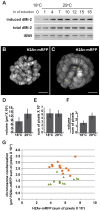
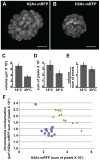

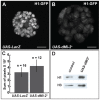
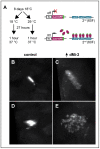


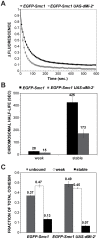

Similar articles
-
Drosophila ISWI regulates the association of histone H1 with interphase chromosomes in vivo.Genetics. 2009 Jul;182(3):661-9. doi: 10.1534/genetics.109.102053. Epub 2009 Apr 20. Genetics. 2009. PMID: 19380479 Free PMC article.
-
Disengaging the Smc3/kleisin interface releases cohesin from Drosophila chromosomes during interphase and mitosis.EMBO J. 2013 Mar 6;32(5):656-65. doi: 10.1038/emboj.2012.346. Epub 2013 Jan 22. EMBO J. 2013. PMID: 23340528 Free PMC article.
-
Mi-2 chromatin remodeling factor functions in sensory organ development through proneural gene repression in Drosophila.Dev Growth Differ. 2006 Sep;48(7):411-8. doi: 10.1111/j.1440-169X.2006.00880.x. Dev Growth Differ. 2006. PMID: 16961588
-
[Chromomeric organization of interphase chromosomes in Drosophila melanogaster].Tsitologiia. 2013;55(3):144-7. Tsitologiia. 2013. PMID: 23795454 Review. Russian.
-
Shaping of the 3D genome by the ATPase machine cohesin.Exp Mol Med. 2020 Dec;52(12):1891-1897. doi: 10.1038/s12276-020-00526-2. Epub 2020 Dec 2. Exp Mol Med. 2020. PMID: 33268833 Free PMC article. Review.
Cited by
-
Redox status and fatty acid composition of Mactra corallina digestive gland following exposure to acrylamide.Environ Sci Pollut Res Int. 2019 Aug;26(22):22197-22208. doi: 10.1007/s11356-019-05492-5. Epub 2019 May 30. Environ Sci Pollut Res Int. 2019. PMID: 31148000
-
Ageing, Drosophila melanogaster and Epigenetics.Malays J Med Sci. 2020 May;27(3):7-19. doi: 10.21315/mjms2020.27.3.2. Epub 2020 Jun 30. Malays J Med Sci. 2020. PMID: 32684802 Free PMC article. Review.
-
Sentinels of chromatin: chromodomain helicase DNA-binding proteins in development and disease.Genes Dev. 2021 Nov 1;35(21-22):1403-1430. doi: 10.1101/gad.348897.121. Genes Dev. 2021. PMID: 34725129 Free PMC article. Review.
-
Cohesin at active genes: a unifying theme for cohesin and gene expression from model organisms to humans.Curr Opin Cell Biol. 2013 Jun;25(3):327-33. doi: 10.1016/j.ceb.2013.02.003. Epub 2013 Mar 1. Curr Opin Cell Biol. 2013. PMID: 23465542 Free PMC article. Review.
-
The Drosophila Helicase Maleless (MLE) is Implicated in Functions Distinct From its Role in Dosage Compensation.Mol Cell Proteomics. 2015 Jun;14(6):1478-88. doi: 10.1074/mcp.M114.040667. Epub 2015 Mar 16. Mol Cell Proteomics. 2015. PMID: 25776889 Free PMC article.
References
-
- Li B, Carey M, Workman JL (2007) The role of chromatin during transcription. Cell 128: 707–719. - PubMed
-
- Bassett A, Cooper S, Wu C, Travers A (2009) The folding and unfolding of eukaryotic chromatin. Curr Opin Genet Dev 19: 159–165. - PubMed
-
- Kouzarides T (2007) Chromatin modifications and their function. Cell 128: 693–705. - PubMed
Publication types
MeSH terms
Substances
Grants and funding
LinkOut - more resources
Full Text Sources
Molecular Biology Databases
Miscellaneous

